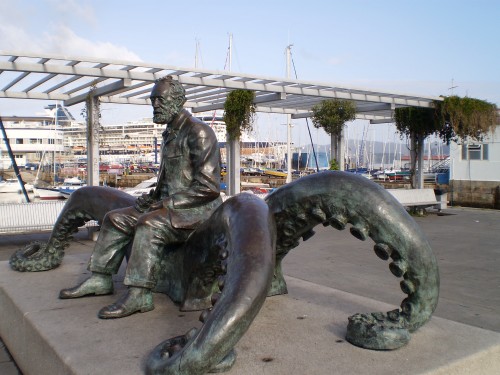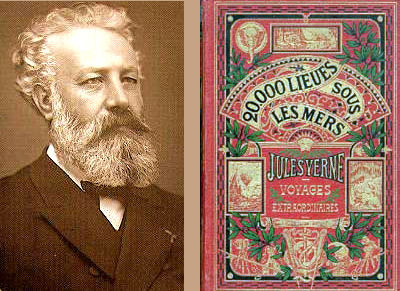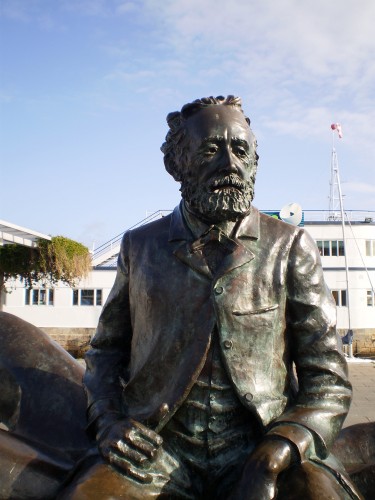JULIO
VERNE
DEDICAMOS ESTE CACHE A UNO DE LOS
MEJORES ESCRITORES DE FICCIÓN QUE HA EXISTIDO

EXTRAIDO DEL LIBRO 20000 LEGUAS DE VIAJE
SUBMARINO, CAPÍTULO VIII -LA BAHIA DE
VIGO-
¿Me ha oído? -dijo el capitán
Nemo-. Le he preguntado si conoce la historia de
España.
-Poco y mal
-respondí.
-Así son los sabios. No saben.
Bien, siéntese, que le voy a contar un curioso episodio de esa
historia.
El capitán se sentó en un diván
y, maquinalmente, me instalé a su lado, en la
penumbra.
-Señor profesor, escúcheme bien,
pues esta historia le interesará en algún aspecto, por responder a
una cuestión que sin duda no ha podido usted
resolver.
-Le escucho, capitán -le dije,
no sabiendo bien adónde quería ir a parar y preguntándome si
tendría aquello relación con nuestro proyecto de
evasión.
-Señor profesor, si no le parece
mal nos remontaremos a 1702. No ignora usted que en esa época,
vuestro rey Luis XIV, creyendo que bastaba con un gesto de
potentado para enterrar los Pirineos, había impuesto a los
españoles a su nieto el duque de Anjou. Este príncipe, que reinó
más o menos mal bajo el nombre de Felipe V, tuvo que hacer frente a
graves dificultades exteriores. En efecto, el año anterior, las
casas reales de Holanda, de Austria y de Inglaterra habían
concertado en La Haya un tratado de alianza, con el fin de arrancar
la corona de España a Felipe V para depositarla en la cabeza de un
archiduque al que prematuramente habían dado el nombre de Carlos
III. España hubo de resistir a esa coalición, casi desprovista de
soldados y de marinos. Pero no le faltaba el dinero, a condición,
sin embargo, de que sus galeones, cargados del oro y la plata de
América, pudiesen entrar en sus puertos.
»Hacia el fin de 1702, España
esperaba un rico convoy que Francia hizo escoltar por una flota de
veintitrés navíos bajo el mando del almirante Cháteau Renault, para
protegerlo de las correrías por el Atlántico de las armadas de la
coalición. El convoy debía ir a Cádiz, pero el almirante, conocedor
de que la flota inglesa surcaba esos parajes, decidió dirigirlo a
un puerto de Francia. Tal decisión suscitó la oposición de los
marinos españoles, que deseaban dirigirse a un puerto de su país, y
que propusieron, a falta de Cádiz, ir a la bahía de Vigo, al
noroeste de España, que no se hallaba bloqueada. El almirante
de
Cháteau Renault tuvo la
debilidad de plegarse a esta imposición, y los galeones entraron en
la bahía de Vigo. Desgraciadamente, esta bahía forma una rada
abierta y sin defensa. Necesario era, pues, apresurarse a descargar
los galeones antes de que pudieran llegar las flotas coaligadas, y
no hubiera faltado el tiempo para el desembarque si no
hubiera
estallado una miserable cuestión
de rivalidades. ¿Va siguiendo usted el encadenamiento de los
hechos?
-Perfectamente -respondí, no
sabiendo aún con qué motivos me estaba dando esa lección de
historia. -Continúo, pues. He aquí lo que ocurrió. Los comerciantes
de Cádiz tenían el privilegio de ser los destinatarios de todas las
mercancías procedentes de las Indias occidentales. Desembarcar los
lingotes de los galeones en el puerto de Vigo era ir contra su
derecho. Por ello, se quejaron en Madrid y obtuvieron del débil
Felipe V que el convoy, sin proceder a su descarga, permaneciera
embargado en la rada de Vigo hasta que se hubieran alejado las
flotas enemigas. Pero, mientras se tomaba esa decisión, la flota
inglesa hacía su aparición en la bahía de Vigo el 22 de octubre de
1702. Pese a su inferioridad material, el almirante de Cháteau
Renault se batió valientemente. Pero cuando vio que las riquezas
del convoy iban a caer entre las manos del enemigo, incendió y
hundió los galeones, que se sumergieron con sus inmensos
tesoros.
El capitán Nemo pareció haber
concluido su relato que, lo confieso, no veía yo en qué podía
interesarme.
-¿Y bien? -le
pregunté.
-Pues bien, señor Aronnax,
estamos en la bahía de Vigo, y sólo de usted depende que pueda
conocer sus secretos.
El capitán se levantó y me rogó
que le siguiera. Le obedecí, ya recuperada mi sangre fría. El salón
estaba oscuro, pero a través de los cristales transparentes
refulgía el mar. Miré.
En un radio de media milla en
torno al Nautilus las aguas estaban impregnadas de luz eléctrica.
Se veía neta, claramente el fondo arenoso. Hombres de la
tripulación equipados con escafandras se ocupaban de inspeccionar
toneles medio podridos, cofres desventrados en medio de restos
ennegrecidos. De las cajas y de los barriles se escapaban lingotes
de oro y plata, cascadas de piastras y de joyas. El fondo estaba
sembrado de esos tesoros. Cargados del precioso botín, los hombres
regresaban al Nautilus, depositaban en él su carga y volvían a
emprender aquella inagotable pesca de oro y de
plata.
Comprendí entonces que nos
hallábamos en el escenario de la batalla del 22 de octubre de 1702
y que aquél era el lugar en que se habían hundido los galeones
fletados por el gobierno español. Allí era donde el capitán Nemo
subvenía a sus necesidades y lastraba con aquellos millones al
Nautilus. Para él, para él sólo había entregado América sus metales
preciosos. Él era el heredero directo y único de aquellos tesoros
arrancados a los incas y a los vencidos por Hernán
Cortés.
-¿Podía usted imaginar, señor
profesor, que el mar contuviera tantas riquezas? -preguntó,
sonriente, el capitán Nemo.
-Sabía que se evalúa en dos
millones de toneladas la plata que contienen las aguas en
suspensión.
-Cierto, pero su extracción
arrojaría un coste superior a de su precio. Aquí, al contrario, no
tengo más que recoger lo que han
perdido los hombres, y no sólo
en esta bahía de Vigo sino también en los múltiples escenarios de
naufragios registrados en
mis mapas de los fondos
submarinos. ¿Comprende ahora por qué puedo disponer de miles de
millones?

A
principios del mes de Junio del año 1878 y aprovechando una
travesía hacia el Mediterráneo a bordo de su famoso y espectacular
yate Saint Michel III, Julio Verne (Nantes,1828-Amiens,1905)
decidió que ya era hora de visitar la Ría de Vigo que el capitán
Nemo frecuentaba con su Nautilus para aprovisionarse en el estrecho
de Rande del oro y la plata necesarios para sus correrías
submarinas.
La historia
del Capitán Nemo la había comenzado a escribir Verne en 1866,
publicándose por primera vez “Veinte Mil Leguas de Viaje
Submarino” en 1869. El escritor quería, pues, reconocer
el escenario imaginado a través de sus lecturas sobre la Batalla de
Rande.
Julio Verne
era un autor conocido mundialmente, una gran celebridad, por lo que
su llegada resultó todo un acontecimiento. Los prohombres vigueses
de entonces, encabezados por Manuel Bárcena, Conde de Torrecedeira,
ya intuían que, a través de su novela, el autor bretón sería el
mayor - en realidad, ya lo era - propagandista que la Ría de Vigo
tuvo jamás.
La
siguiente reseña se podía leer en un diario local el 3 de Junio de
aquel año 1878:
“Casi al mismo tiempo que el
Flore soltó el ancla en este puerto, presentóse cruzando la ría un
bonito yatch de vapor con pabellón francés; era el Saint Michel
Nantes, propiedad del popular novelista Julio Verne, que con otros
amigos va de paso para el Mediterráneo, donde piensa visitar
algunas poblaciones de España.- El famoso novelista estuvo anoche
en el paseo de la Alameda, y más tarde concurrió al baile de La
Tertulia, donde pronunció algunos brindis en español, los cuales
fueron contestados por el Sr. Bárcena (D.Manuel) como presidente de
la sociedad.- Es indudable que Mr.Verne, a quien le ha agradado
mucho la posición geográfica de Vigo y su pintoresca campiña, lleva
a la vez grato recuerdo de la sociedad viguesa que tuvo ocasión de
conocer bajo uno de sus más bellos aspectos, en un baile de La
Tertulia”.

La visita de Julio Verne y los
invitados que con él viajaban se prolongó más de una semana, puesto
que aprovechó para realizar en el astillero que Antonio Sanjurjo
Badía poseía en el Areal algunos ajustes y reparaciones en su
barco, que era nuevo adquirido tan sólo unos meses antes.
Camino de Lisboa, Cádiz, Tánger, Tetuán y Argel, el periplo
previsto, el Saint Michel III era un gran barco a vela y vapor de
31 metros de eslora y 38 toneladas de desplazamiento que contaba
con una tripulación de diez hombres.
Parece ser, según testimonios de los descendientes del industrial
vigués, que posteriomente Julio Verne, satisfecho de los ajustes
realizados en Vigo a su yate,mantuvo correspondencia con Antonio
Sanjurjo Badía.
El monumento a Julio Verne está
situada en el Náutico, y el autor de la obra es el vigués José
Molares.
La pieza está realizada en
bronce, de 4 metros de ancho y casi 1,80 metros de alto, unida a su
enorme base de granito.
A su inauguración allá por el
año 2005 asistieron numerosos rostros conocidos de la
politica,

EL
CACHE
Es un microcache magnético que
contiene solamente logbook, por lo tanto llevar material de escritura, la
zona es muy transitada, lo mejor es disimular que sacas una foto,
prestad atención a la
pista y dejar el cache bién
escondido
JULIO VERNE
I dedicate this CACHE TO ONE
OF THE BEST WRITERS OF FICTION that there has
been
Excerpted from the book 20,000 Leagues Under
the Sea, CHAPTER VIII-THE BAY OF VIGO-
Do you hear
me? "Said Captain Nemo. I asked if you know the history of
Spain.
"A little, poorly-answered.
"So are the wise. Do not know. Well, sit down, he'll tell
you a curious episode in this history.
The captain sat down on a couch
and, mechanically, I moved to his side in the dark.
"Sir, listen well, because this story will interest you in some
way, to answer a question that surely you could not solve.
"I listen, Captain," I said, not knowing well what he was going to
stop and wondering if things would have bearing on our draft
evasion.
"Professor, if not it bad we will go back to 1702.
Do not ignore you at that time,
your King Louis XIV, thinking that was enough for one gesture of a
potentate to bury the Pyrenees, the Spanish had imposed his
grandson the Duke of Anjou. This prince, who reigned more or less
badly under the name of Philip V, had to face serious external
constraints. Indeed, the previous year, the royal houses of
Holland, Austria and England had concluded in The Hague a treaty of
alliance, to start the crown of Spain to Philip V to deposit on the
head of an archduke to whom prematurely had given the name of
Carlos III. Spain had to
withstand such a coalition, almost devoid of soldiers and sailors.
But he lacked the money, provided, however, that their galleons,
laden with gold and silver in America, could enter its ports.
"Toward the end of 1702, Spain expected a rich convoy
which France was escorting a fleet of twenty ships under the
command of Admiral Chateau Renault, to protect it from raids by the
Atlantic coalition navies. The convoy had to go to Cadiz, but the
Admiral, aware that the English fleet plowed these parts, decided
to go to a French port. This decision was opposed by the Spanish
sailors who wanted to go to a port in his country and suggested, in
the absence of Cadiz, go to the Bay of Vigo, northwestern Spain,
which was not locked. Admiral
Chateau Renault was weak enough to bend in this notice and the
galleons entered Vigo Bay. Unfortunately, this bay is an open
roadstead and defenseless. Was necessary, therefore, hasten to
unload the galleons before they could reach the fleet in league,
and had not missed the time for the landing if it had not
exploded a miserable question of rivalry. Will you follow the chain
of events?
"Fine," I replied, not even knowing what reasons I was giving this
lesson of history. "Go, then. Here's what happened. The merchants
of Cadiz had the privilege of being the recipients of all goods
from the West Indies. Landing ingots of galleons in the port of
Vigo was going against his right. Therefore, complained in Madrid
and obtained the weak Philip V the convoy, without a download, to
remain seized in the harbor of Vigo until the enemy fleets had been
removed. But while this decision was taken, the English fleet made
its appearance in the Bay of Vigo on October 22, 1702. Despite
their inferior material, Admiral de Chateau Renault fought bravely.
But when he saw the wealth of the convoy would fall into the hands
of enemy fire and sank the galleon, which were immersed with their
immense treasures.
Captain Nemo seemed to have concluded his story, I confess, I did
not see what could be interested.
- Well? I asked.
"Well, sir Aronnax, we are in the Bay of Vigo, and only up to you
that you can learn its secrets.
The captain stood up and asked me to follow him. I obeyed him, and
recovered my coolness. The room was dark, but through the
transparent crystals sparkled the sea. I looked.
In a half-mile radius around the Nautilus, the waters were
saturated with electric light. Net looked clearly the sandy bottom.
Crewmen equipped with diving suits were busy inspecting rotting
barrels, chests desventrados amid blackened remains. Of the boxes
and barrels escaped ingots of gold and silver, cascades of piastres
and jewels. The bottom was strewn with such treasures. Loaded the
precious booty, the men returned to the Nautilus, it deposited its
cargo and returned to take that inexhaustible fishery of gold and
silver.
I realized then that we were at the scene of the battle of October
22, 1702 and that this was the place where the galleons were sunk
by the Spanish government chartered. That was where Captain Nemo
maintained them in their needs and burdened with those millions to
Nautilus. For him, for he had only delivered America its precious
metals. He was the only direct heir of those treasures torn from
the Incas and conquered by Hernán Cortés.
- Could you imagine, sir, that the sea contained such riches? He
asked, smiling, Captain Nemo.
"I knew it was estimated at two million tonnes silver containing
water in suspension.
"True, but its removal would produce a cost exceeding its price.
Here, in contrast, I have only to collect what they have
lost men, and not only in this Bay of Vigo but also in multiple
scenarios recorded shipwrecks
my maps of the seabed. Do you understand now why I can dispose of
billions?
In early June of 1878 and making a voyage to the Mediterranean
aboard his yacht famous and spectacular Saint Michel III, Julio
Verne (Nantes ,1828-Amiens, 1905) decided that it was time to visit
the Ria de Vigo that Captain Nemo in his Nautilus frequented for
supplies in the strait of Rande gold and silver necessary for his
travels underwater.
The story of Captain Nemo had begun to write Verne in 1866, first
published "Twenty Thousand Leagues Under the Sea" in 1869. The
writer wanted, then, to recognize the scenario imagined by his
reading about the Battle of Rande.
Jules Verne was an author known worldwide, a big celebrity, so that
their arrival was an event. The Vigo notables of the time, led by
Manuel Barcena, Earl of Torrecedeira already felt that, through his
novel, the author would be the greatest Briton - actually, I was -
propagandist Ria de Vigo ever had.
The next review could be read in a local newspaper on June 3
that year 1878:
"Almost at the same time as the Flore dropped
anchor in this port, presented himself across the river a beautiful
steam yacht flying the French flag, was the Saint Michel Nantes,
owned by the popular novelist Jules Verne, who with other friends
go from step to Mediterranean, where he plans to visit several
towns in Spain .- The famous novelist was last night in the Paseo
de la Alameda, and later attended the dance at La Tertulia, where
he gave some toast in Spanish, which were answered by Mr. Barcena (
D. Manuel) as president of the society .- Mr.Verne Certainly, who
would have liked very much the geographical position of Vigo and
its picturesque countryside, carrying both fond memories of Vigo
society had the opportunity to know under one of its most beautiful
aspects, in a dance of The Gathering. "
The visit of Jules Verne and guests traveling with him that lasted
more than a week, since it took to perform in the yard to Antonio
Sanjurjo Badia the Areal had some adjustments and repairs on his
boat, which was purchased new just a few months earlier.
Road to Lisbon, Cadiz, Tangier, Tetouan and Algiers, the journey
planned, the Saint Michel III was a great boat to sail and steam 31
meters in length and 38 tons displacement which had a crew of ten
men.
It seems, according to testimony from descendants of the
industrialist Vigo, who subsequently be Jules Verne, satisfied with
the adjustments made in Vigo to his yacht, corresponded with
Antonio Sanjurjo Badia.
The monument to Jules Verne is
located in the Marina, and the author of the work is the Vigo
Joseph Barfield.
The piece is made of bronze,
four meters wide and almost 1.80 meters high, together with its
huge granite base.
In its opening back in 2005 attended by many
familiar faces from politics,
THE
CACHE
It is a magnetic
microcache, logbook containing only therefore carry writing
materials, the area is extremely busy, it's best to hide the fact
that you take a picture, pay attention to the track and leave the
cache well hidden
